Physical Address
304 North Cardinal St.
Dorchester Center, MA 02124
Hemostasis is a process that maintains normal blood flow through healthy vessels but, when a vessel is damaged, rapidly generates a platelet plug (primary hemostasis) and subsequent thrombin clot (secondary hemostasis) at the site of vascular injury. The major components of the hemostatic mechanism are the platelets, the anticoagulant proteins, the procoagulant proteins, and the various components of the vascular wall. Normal hemostasis is an interactive process in which each element cooperates closely to generate a rapid, cohesive, focused reaction. An abnormality of one element destabilizes the system, but significant clinical symptoms often manifest only when two components are affected. Typical examples include the patient with hemophilia who bleeds after sustaining trauma and the antithrombin (AT)-deficient woman in whom thrombosis develops during pregnancy. The astute clinician is aware of situations that may exacerbate preexisting conditions. Pretreatment of known predisposing conditions can prevent complications, as exemplified by infusion of factor VIII (factor 8 ∗
∗ Established international nomenclature refers to the clotting factors by their respective Roman numerals. However, for this general pediatrics textbook, we have chosen here to use Arabic numerals to avoid confusion that results on occasion from use of Roman numerals.
) concentrate before and after surgery to a patient with hemophilia A to prevent excessive bleeding. Table 51.1 shows common bleeding symptoms and the most common disorders that trigger these symptoms.
| Mucocutaneous Bleeding |
|
|
|
|
|
|
|
|
|
| Deep/Surgical Bleeding |
|
|
|
| Trauma |
| Generalized Bleeding |
|
|
|
|
Two opposing systems generate local clots but limit the clot to the area of vascular damage. Fig. 51.1 shows the sequence of activation of coagulation. The cascade is capable of rapid response because generation of a small number of activated factors at the “top” of the cascade leads to thousands of molecules of thrombin (factor 2). Deficiencies of proteins at or below factors 11 or 7 in the coagulation cascade sequence result in clinical bleeding symptoms, whereas deficiencies of factor 12, prekallikrein, and high-molecular-weight kininogen do not. The coagulation mechanism is continuously generating a small amount of thrombin. If there is trauma, tissue factor (TF) and factor 7 combine to activate factor 10 to factor 10a both directly and indirectly via factor 9. Factor 10a then forms a complex on a membrane surface (provided by the activated platelet) with factor 5 and calcium, resulting in even more thrombin generation. Platelets adhere to exposed subendothelial material in areas of vessel injury, thus generally restricting thrombin generation and clot formation to the area of damage.
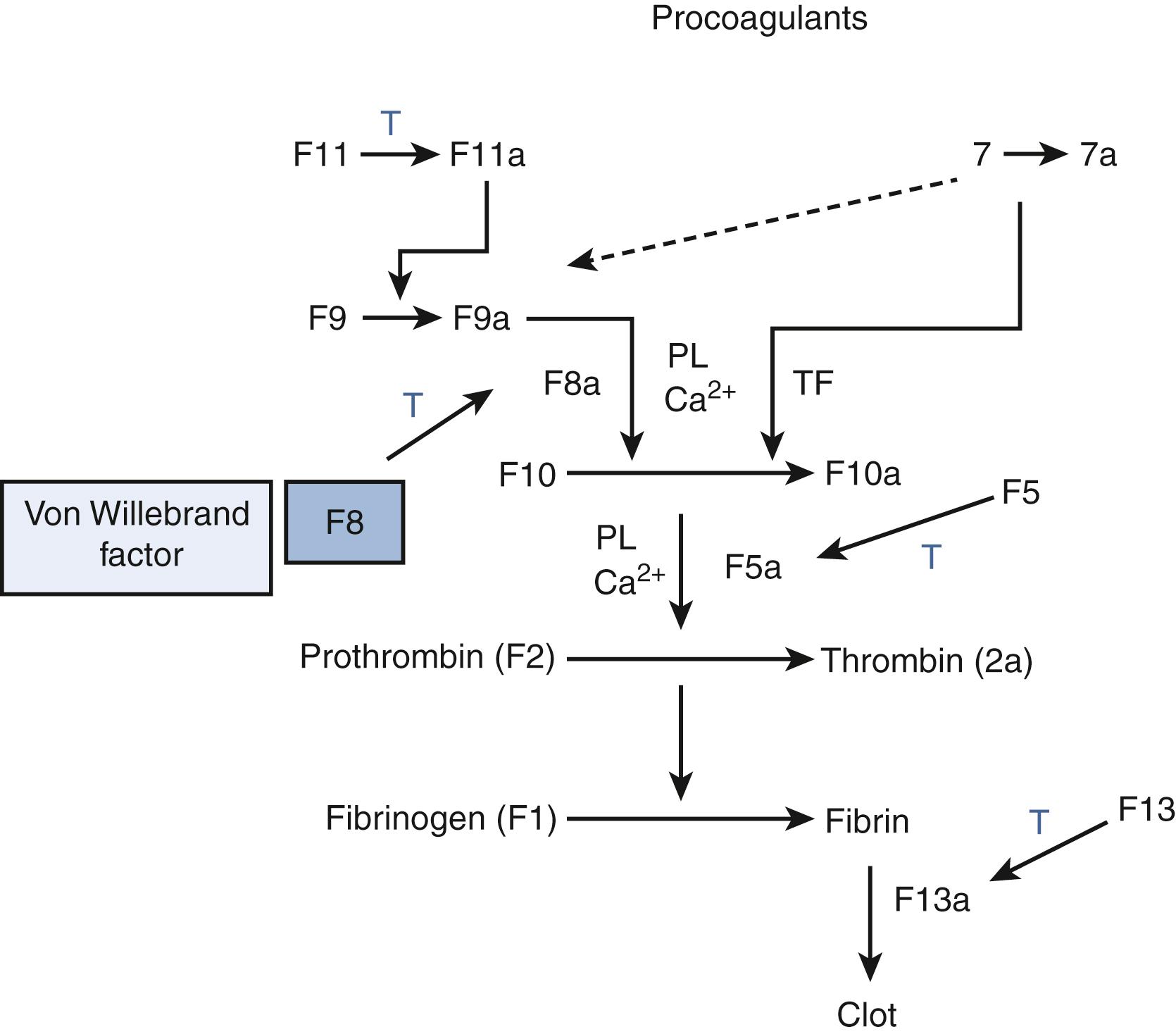
Thrombin exerts positive feedback on the system by acting on factor 11 to trigger the intrinsic system, cleaving factors 5 and 8 to activate them, further accelerating thrombin generation, aggregating platelets, and activating factor 13. Clotting proteins, along with enzymes and zymogens, circulate in concert and a rapid activation cascade ensues with the exposure to damaged endothelium. This dynamic system concept allows for expeditious cessation of bleeding but underscores the impact of deficiencies in anticoagulant protein when thrombin is being continuously generated. A deficiency of an inhibitory enzyme or a cofactor removes part of the “brakes” on the system and causes increased thrombin generation.
Four key systems interact to inhibit the coagulation mechanism:
AT
Protein C/S system
Fibrinolytic system
Tissue factor pathway inhibitor (TFPI)
AT is a member of the serine protease inhibitor family (serpins) that inhibits thrombin, factor 10a, and, less efficiently, factors 9a and 11a. When AT is bound to heparin, this reaction is accelerated 1,000-fold. AT is the active anticoagulant operative during heparin therapy; if AT is deficient, the activity of heparin is compromised. Heparin-like molecules are synthesized by endothelial cells and interact with AT on the vessel wall to inhibit coagulation. Both congenital and acquired AT deficiencies are associated with a predisposition toward thrombosis. AT is consumed during clotting.
The protein C (PC)/protein S (PS) system is complex and limits clot extension by inactivating the rate-limiting coenzymes of the coagulation cascade, factors 5 and 8. To prevent extension of the clot, the anticoagulant mechanism must limit thrombin formation to areas of vascular damage. First, thrombin binds to the protein thrombomodulin on intact endothelial cells. Thrombomodulin-bound thrombin then converts protein C into its activated form, activated protein C (APC). APC then combines with protein S to inactivate factors 5 and 8. In addition, APC may promote fibrinolysis. Thrombin itself is inactivated when bound to thrombomodulin and simultaneously augments the anticoagulant response by generating APC. APC limits the amount of thrombin that can be generated subsequently.
AT, PC, and PS are important inhibitors of clotting because deficiencies of each of these proteins, either inherited or acquired, are associated with an increased risk for thrombosis. A gene variant in factor 5 (factor 5 Leiden) that makes it less susceptible to proteolysis by APC (resistance to APC) is the most common hereditary predisposition to thrombosis, although it imparts only a modest increase in absolute risk. TFPI is an inhibitor of factor 7a ( Fig. 51.2 ).
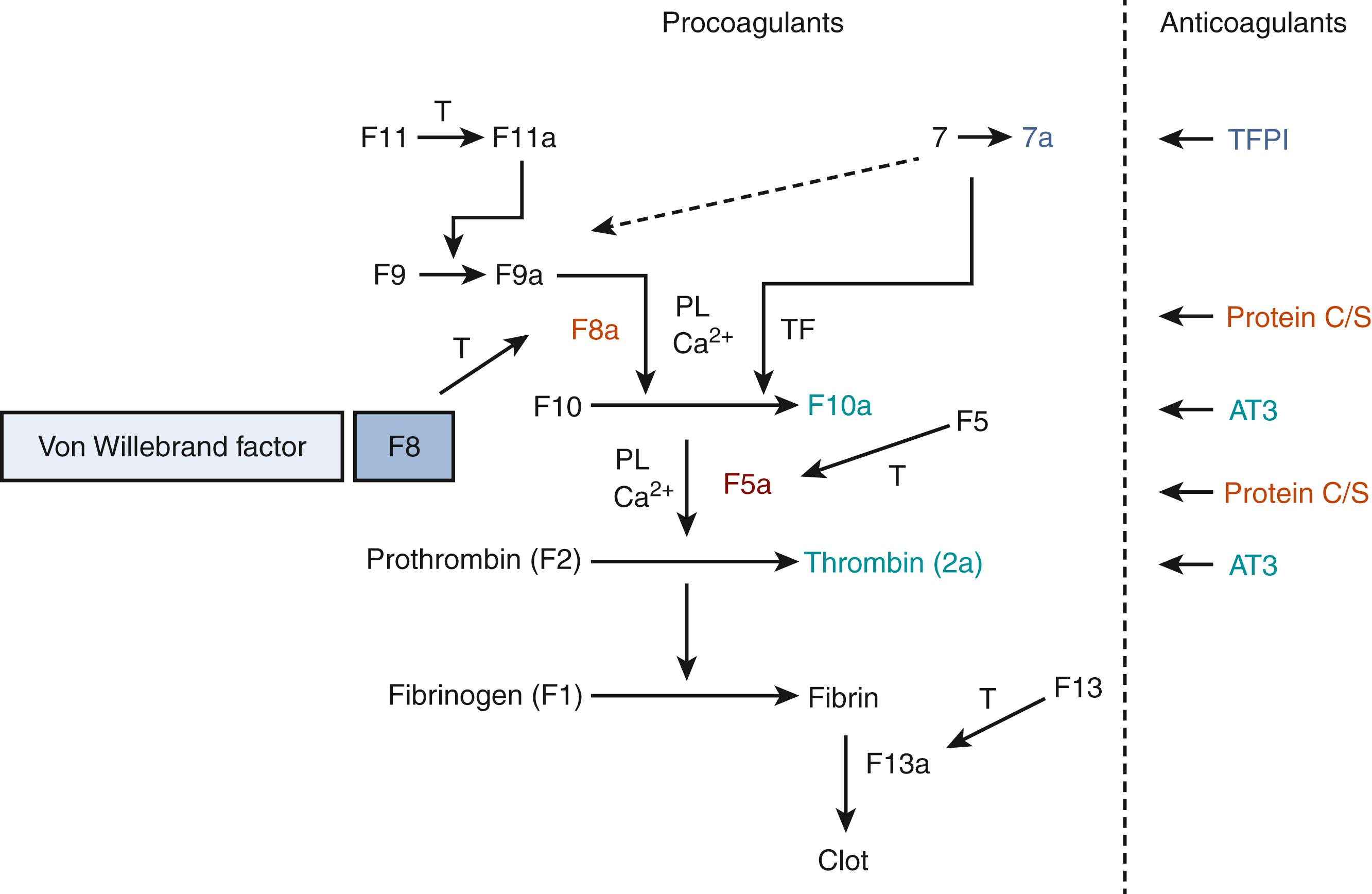
The fibrinolytic system dissolves and removes clots from the vascular system so that normal flow through vessels can be restored. Endothelial cells synthesize two activators of plasminogen: tissue-type plasminogen activator (tPA) and urokinase, both of which convert plasminogen to plasmin, the enzyme that degrades fibrin. Normally, plasminogen activator and its inhibitor, plasminogen activator inhibitor (PAI-I), are synthesized in equimolar amounts and are released from endothelial cells in parallel, leading to minimal amounts of active fibrinolysis. Increased activation or damage to the vascular system can alter this balance, however, and result in increased tPA release, thus generating plasmin and lysing local clots. Plasminogen activator has been synthesized in a recombinant form (rtPA) and is an effective pharmacologic fibrinolytic agent in vivo.
Clotting is initiated when platelets adhere to damaged endothelium ( Fig. 51.3 ). In areas of vascular damage, the adhesive protein, von Willebrand factor (VWF), binds to the exposed subendothelial collagen matrix and undergoes a conformational change. VWF then binds to its platelet receptor, glycoprotein Ib, and activates platelets. Activated platelets secrete adenosine diphosphate (ADP), which induces nearby circulating platelets to aggregate. Platelet-to-platelet cohesion is mediated by the binding of fibrinogen (clotting factor 1) to its platelet receptor, glycoprotein IIb/IIIa (α iib β 3 ). Therefore, both VWF and fibrinogen play essential roles in normal platelet function in vivo. Simultaneously with the platelet adhesion-aggregation response, coagulation is being activated. The phospholipid-rich platelet membrane brings the reactants of the cascade into close proximity, promoting rapid, effective factor catalysis and accelerating the reactions 1,000-fold faster than would occur in the absence of the appropriate surface.
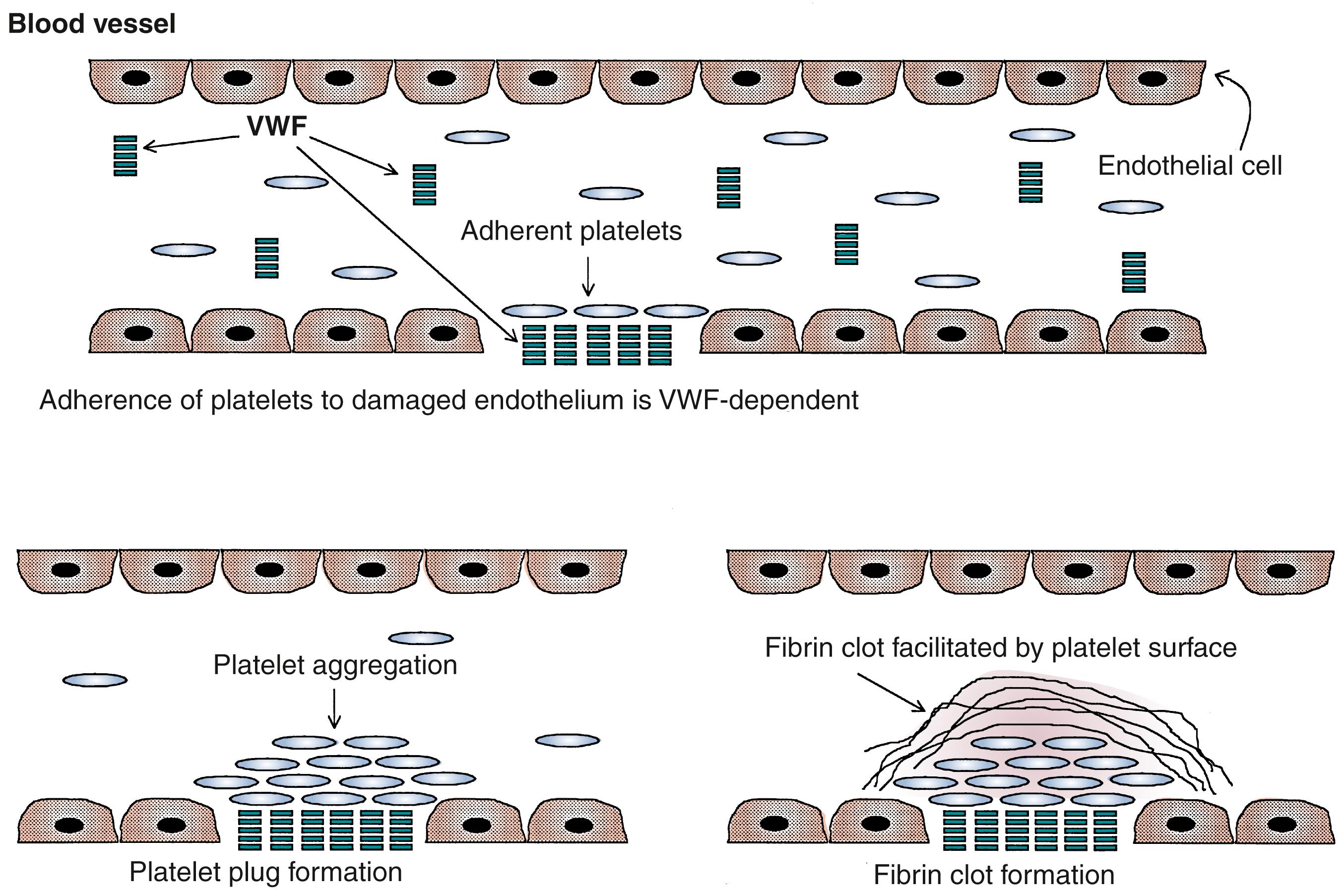
Normally, endothelial cells provide an antithrombotic surface through which blood flows without interruption. The endothelial cell is capable of a rapid change in function and character so that it can augment coagulation after stimulation with a variety of modulating agents, including lymphokines and cytokines, as well as noxious agents such as endotoxin and infectious viruses ( Fig. 51.4 ). Widespread alteration of endothelial cell function can shift and disregulate the hemostatic response and promote activation of clotting, which is the probable mechanism by which sepsis induces the clinical syndrome of disseminated intravascular coagulation (DIC).
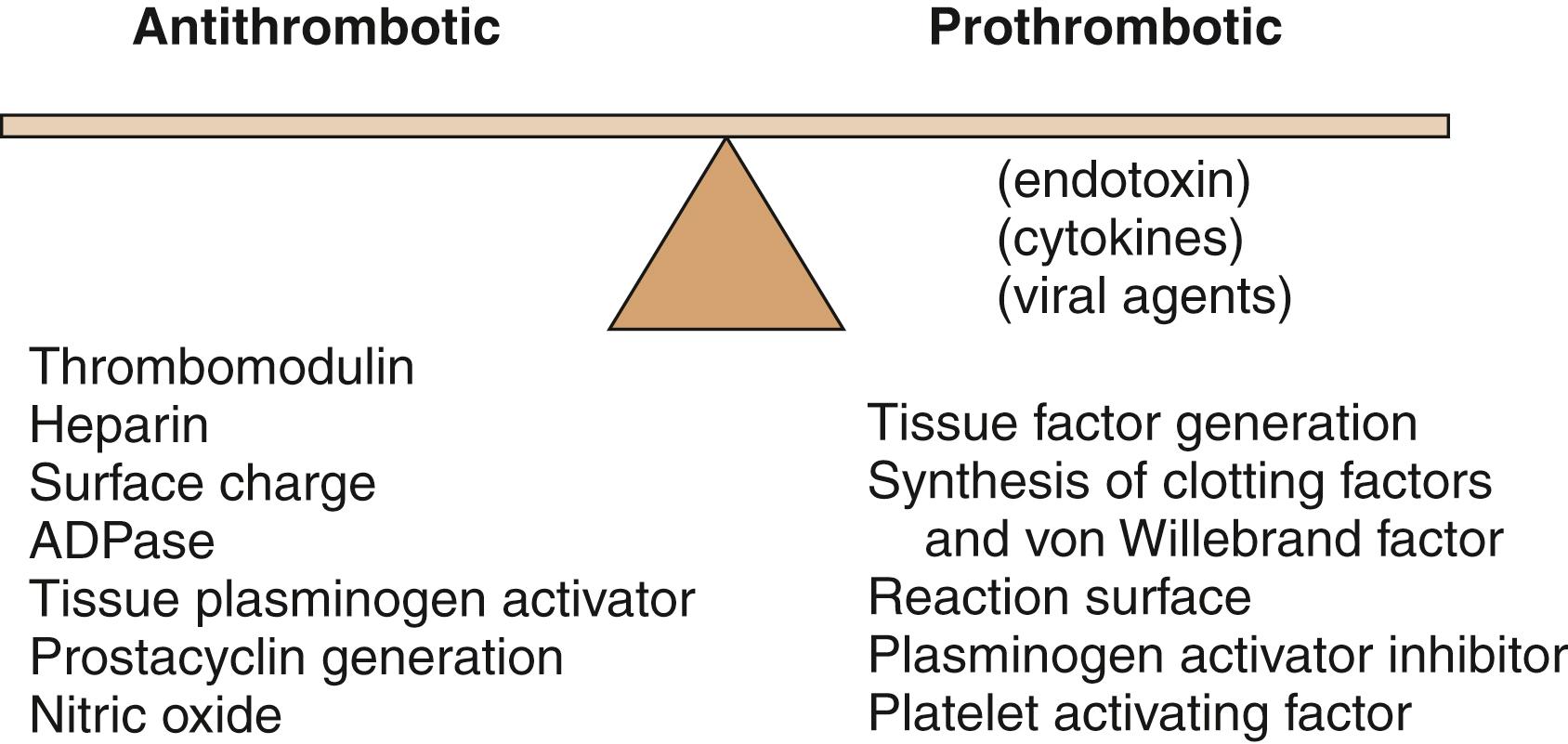
Hemostatic disorders in newborns are more common than at any other pediatric age. The neonate is relatively deficient in most procoagulant and anticoagulant proteins. Platelet function may also be impaired. Blood flow characteristics in the newborn are unique because of the high hematocrit, small-caliber vessels, low blood pressure, and special areas of vascular fragility. Table 51.2 presents the normal values for coagulation screening tests and procoagulant proteins in preterm and full-term infants, as well as in older children. Table 51.3 presents age-specific values for the anticoagulant and fibrinolytic proteins.
| Test | 19–27 Wk Gestation † | 28–31 Wk Gestation † | 30–36 Wk Gestation | Full Term | 1–5 Yr | 6–10 Yr | 11–18 Yr | Adult |
|---|---|---|---|---|---|---|---|---|
| PT (sec) | — | 15.4 (14.6–16.9) | 13.0 (10.6–16.2) | 13.0 (10.1–15.9) | 11 (10.6–11.4) | 11.1 (10.1–12.0) | 11.2 (10.2–12.0) | 12 (11.0–14.0) |
| INR | — | — | 1.0 (0.61–1.7) | 1.00 (0.53–1.62) ‡ | 1.0 (0.96–1.04) | 1.01 (0.91–1.11) | 1.02 (0.93–1.10) | 1.10 (1.0–1.3) |
| aPTT (sec) | — | 108 (80–168) | 53.6 (27.5–79.4) ‡ § | 42.9 (31.3–54.3) ‡ | 30 (24–36) | 31 (26–36) | 32 (26–37) | 33 (27–40) |
| Fibrinogen (factor 1) | 1.00 (±0.43) | 2.56 (1.60–5.50) | 2.43 (1.50–3.73) ‡ § | 2.83 (1.67–3.99) | 2.76 (1.70–4.05) | 2.79 (1.57–4.0) | 3.0 (1.54–4.48) | 2.78 (1.56–4.0) |
| Bleeding time (min) | — | — | — | — | 6 (2.5–10) ‡ | 7 (2.5–13) ‡ | 5 (3.8) ‡ | 4 (1–7) |
| Prothrombin (factor 2) | 0.12 (±0.02) | 0.31 (0.19–0.54) | 0.45 (0.20–0.77) ‡ | 0.48 (0.26–0.70) ‡ | 0.94 (0.71–1.16) ‡ | 0.88 (0.67–1.07) ‡ | 0.83 (0.61–1.04) ‡ | 1.08 (0.70–1.46) |
| Factor 5 | 0.41 (±0.10) | 0.65 (0.43–0.80) | 0.88 (0.41–1.44) § | 0.72 (0.34–1.08) ‡ | 1.03 (0.79–1.27) | 0.90 (0.63–1.16) ‡ | 0.77 (0.55–0.99) ‡ | 1.06 (0.62–1.50) |
| Factor 7 | 0.28 (±0.04) | 0.37 (0.24–0.76) | 0.67 (0.21–1.13) ‡ | 0.66 (0.28–1.04) ‡ | 0.82 (0.55–1.16) ‡ | 0.86 (0.52–1.20) ‡ | 0.83 (0.58–1.15) ‡ | 1.05 (0.67–1.43) |
| Factor 8 procoagulant | 0.39 (±0.14) | 0.79 (0.37–1.26) | 1.11 (0.5–2.13) | 1.00 (0.50–1.78) | 0.90 (0.59–1.42) | 0.95 (0.58–1.32) | 0.92 (0.53–1.31) | 0.99 (0.50–1.49) |
| VWF | 0.64 (±0.13) | 1.41 (0.83–2.23) | 1.36 (0.78–2.10) | 1.53 (0.50–2.87) | 0.82 (0.60–1.20) | 0.95 (0.44–1.44) | 1.00 (0.46–1.53) | 0.92 (0.50–1.58) |
| Factor 9 | 0.10 (±0.01) | 0.18 (0.17–0.20) | 0.35 (0.19–0.65) ‡ , § | 0.53 (0.15–0.91) † , ‡ | 0.73 (0.47–1.04) ‡ | 0.75 (0.63–0.89) ‡ | 0.82 (0.59–1.22) ‡ | 1.09 (0.55–1.63) |
| Factor 10 | 0.21 (±0.03) | 0.36 (0.25–0.64) | 0.41 (0.11–0.71) ‡ | 0.40 (0.12–0.68) ‡ | 0.88 (0.58–1.16) ‡ | 0.75 (0.55–1.01) ‡ | 0.79 (0.50–1.17) | 1.06 (0.70–1.52) |
| Factor 11 | — | 0.23 (0.11–0.33) | 0.30 (0.08–5.2) ‡ , § | 0.38 (0.40–0.66) ‡ | 0.97 (0.52–1.50) ‡ , § | 0.86 (0.52–1.20) | 0.74 (0.50–0.97) ‡ | 0.97 (0.67–1.27) |
| Factor 12 | 0.22 (±0.03) | 0.25 (0.05–0.35) | 0.38 (0.10–0.66) ‡ , § | 0.53 (0.13–0.93) ‡ | 0.93 (0.64–1.29) | 0.92 (0.60–1.40) | 0.81 (0.34–1.37) ‡ | 1.08 (0.52–1.64) |
| PK | — | 0.26 (0.15–0.32) | 0.33 (0.09–0.89) ‡ | 0.37 (0.18–0.69) ‡ | 0.95 (0.65–1.30) | 0.99 (0.66–1.31) | 0.99 (0.53–1.45) | 1.12 (0.62–1.62) |
| HMWK | — | 0.32 (0.19–0.52) | 0.49 (0.09–0.89) ‡ | 0.54 (0.06–1.02) ‡ | 0.98 (0.64–1.32) | 0.93 (0.60–1.30) | 0.91 (0.63–1.19) | 0.92 (0.50–1.36) |
| Factor 13a | — | — | 0.70 (0.32–1.08) ‡ | 0.79 (0.27–1.31) ‡ | 1.08 (0.72–1.43) | 1.09 (0.65–1.51) | 0.99 (0.57–1.40) | 1.05 (0.55–1.55) |
| Factor 13b | — | — | 0.81 (0.35–1.27) ‡ | 0.76 (0.30–1.22) ‡ | 1.13 (0.69–1.56) ‡ | 1.16 (0.77–1.54) ‡ | 1.02 (0.60–1.43) | 0.98 (0.57–1.37) |
∗ All factors except fibrinogen (mg/mL) are presented as U/mL, where pooled normal plasma contains 1 U/mL. All data are expressed as the mean followed by the upper and lower boundaries encompassing 95% of the normal population.
† Levels for 19–27 wk and 28–31 wk are from multiple sources and cannot be analyzed statistically.
‡ Values are significantly different from those of adults.
§ Values are significantly different from those of full-term infants.
| Inhibitor | 19–27 Wk Gestation † | 28–31 Wk Gestation † | 30–36 Wk Gestation | Full Term | 1–5 Yr | 6–10 Yr | 11–18 Yr | Adult |
|---|---|---|---|---|---|---|---|---|
| AT3 | 0.24 (±0.03) ‡ | 0.28 (0.20–0.38) ‡ | 0.38 (0.14–0.62) ‡ , § | 0.63 (0.39–0.87) ‡ | 1.11 (0.82–1.39) | 1.11 (0.90–1.31) | 1.06 (0.77–1.32) | 1.0 (0.74–1.26) |
| Protein C | 0.11 (±0.03) ‡ | — | 0.28 (0.12–0.44) ‡ , § | 0.35 (0.17–0.53) ‡ | 0.66 (0.40–0.92) ‡ | 0.69 (0.45–0.93) ‡ | 0.83 (0.55–1.11) ‡ | 0.96 (0.64–1.28) |
| Protein S | — | — | — | — | — | — | — | — |
| Total (U/mL) | — | — | 0.26 (0.14–0.38) ‡ , § | 0.36 (0.12–0.60) ‡ | 0.86 (0.54–1.18) | 0.78 (0.41–1.14) | 0.72 (0.52–0.92) | 0.81 (0.61–1.13) |
| Free (U/mL) | — | — | — | — | 0.45 (0.21–0.69) | 0.42 (0.22–0.62) | 0.38 (0.26–0.55) | 0.45 (0.27–0.61) |
| Plasminogen (U/mL) | — | — | 1.70 (1.12–2.48) ‡ | 1.95 (1.25–2.65) ‡ | 0.98 (0.78–1.18) | 0.92 (0.75–1.08) | 0.86 (0.68–1.03) | 0.99 (0.77–1.22) |
| TPA (ng/mL) | — | — | 8.48 (3.00–16.70) | 9.6 (5.0–18.9) | 2.15 (1.0–4.5) ‡ | 2.42 (1.0–5.0) ‡ | 2.16 (1.0–4.0) ‡ | 1.02 (0.68–1.36) |
| α 2 AP (U/mL) | — | — | 0.78 (0.40–1.16) | 0.85 (0.55–1.15) | 1.05 (0.93–1.17) | 0.99 (0.89–1.10) | 0.98 (0.78–1.18) | 1.02 (0.68–1.36) |
| PAI–1 | — | — | 5.4 (0.0–12.2) ‡ | 5.42 (1.0–10.0) | 5.42 (1.0–10.0) | 6.79 (2.0–12.0) ‡ | 6.07 (2.0–10.0) ‡ | 3.60 (0–11.0) |
∗ All values are expressed in U/mL, where pooled plasma contains 1 U/mL, with the exception of free protein S, which contains a mean of 0.4 U/mL. All values presented as the mean by the upper and lower boundaries encompassing 95% of the population.
† Levels for 19–27 wk and 28–31 wk are from multiple sources and cannot be analyzed statistically.
‡ Values are significantly different from those of adults.
§ Values are significantly different from those of full-term infants.
Levels of factors 5 and 8, fibrinogen, VWF, and platelets become normal by 28 weeks of gestation. PS levels are also close to normal at birth, but levels of other anticoagulant proteins, especially PC, AT, and plasminogen, are low in full-term infants and are even lower in premature neonates. The levels of most procoagulant and anticoagulant proteins increase throughout gestation; therefore, the most immature infant has the lowest levels of these proteins and is at the highest risk for either bleeding or thrombotic complications.
Vitamin K deficiency is a particular problem of the newborn. Vitamin K is a fat-soluble vitamin that induces the post-translational γ-carboxylation of the vitamin K–dependent substances (factors 2, 7, 9, and 10; PC; and PS). This carboxylation step occurs after the protein is synthesized in the liver and must occur for a vitamin K–dependent coagulation factor to bind calcium, the bridge to the membrane surface on which these proteins form complexes with other members of the clotting cascade and catalyze subsequent reactions. Vitamin K deficiency effectively renders these proteins unable to bind to a surface. Most of the vitamin K in adults originates from the diet and from bacterial production in the intestine. The breast-fed neonate is at high risk for vitamin K deficiency because human milk is relatively deficient in vitamin K, the neonatal liver itself is immature with reduced carboxylation function, and the newborn’s gut requires several days to develop normal bacterial flora.
Severe vitamin K deficiency in neonates, vitamin K–dependent bleeding (VKDB), occurs in breast-fed infants who have not received intramuscular vitamin K prophylaxis. VKDB can be classified by age of onset into early (<24 hours), classical (days 1–7), and late (>1 week to <6 months), and by etiology into idiopathic and secondary. In secondary VKDB, in addition to breast-feeding, other predisposing factors are apparent, such as poor intake or malabsorption of vitamin K (hepatobiliary disease). Such infants may experience diffuse bleeding and even central nervous system hemorrhage. VKDB is an extraordinarily rare event in the United States, occurring in <2% of live births, because of nearly universal neonatal administration of vitamin K. In the evaluation of bleeding in a newborn, the clinician should confirm that vitamin K has been administered. Patients with disorders of the gastrointestinal tract, those taking broad-spectrum antibiotics, those born of mothers who received phenobarbital or phenytoin during pregnancy (very–early-onset VKDB), and those with cholestasis and malabsorption (late-onset VKDB) are at higher risk for vitamin K deficiency.
Table 51.4 is an outline of historical questions that are important for the diagnosis of bleeding disorders as it is critical to obtain quantifiable, precise information. Easy bruising and nosebleeds are common in children, although the presence of large (>2 inches in diameter) bruises at multiple sites, prolonged nosebleeds (>15–30 minutes), and hematoma formation are seen in up to 20–40% of children with a bleeding disorder. Bleeding postcircumcision should raise the suspicion of hemophilia, while bleeding from the umbilical cord stump is associated with factor 13 deficiency. Some helpful questions include “What was the biggest bruise you ever had, and what caused it?” and “Have you ever noted little red dots (petechiae) on your skin?”
|
∗ Significant historical information is presented in boldface type.
A personal or family history of gynecologic bleeding is often valuable. Menorrhagia causing iron-deficiency anemia, bleeding after childbirth, or need for red blood cell transfusion or early hysterectomy because of bleeding is often inappropriately assumed to have anatomic causes (“dysfunctional uterine bleeding”). The clinician must ascertain the number of pads used per day, in addition to the length and frequency of each menstrual cycle. If the majority of females in a family have an underlying bleeding disorder, then that family’s “normal menstrual periods” may be quite abnormal. Many adolescent females with menorrhagia caused by an underlying bleeding disorder respond to oral contraceptive agents; therefore, improvement in bleeding symptoms after starting oral contraceptive agents does not rule out a bleeding disorder.
Historical information is equally important in deciding who requires evaluation for a predisposition to thrombosis. Virtually all pediatric patients in whom a blood clot develops in the absence of major vascular instrumentation, catheter placement, underlying infection, or other inflammatory state merit careful laboratory screening for a prothrombotic state (a hereditary or acquired disorder that predisposes to clotting). Even in the situation of a provoked thrombosis, a detailed family history should be documented for early-onset stroke; early myocardial infarction; and blood clots in the veins, arteries, or lungs.
The most important determination is whether the patient appears acutely or chronically ill, including vital signs and growth parameters. The nose should be examined for ulcers or anatomic bleeding sites, and the heart should be examined for the presence of murmurs (as occur in anemia and endocarditis). Joints should be examined for chronic arthropathy (as occurs in hemophilia) or joint laxity (as occurs in Ehlers-Danlos syndrome), and the extremities are examined for thumb or radial anomalies (thrombocytopenia–absent radius syndrome, or Fanconi anemia). The abdomen and lymph nodes should be examined for the presence of hepatosplenomegaly and adenopathy.
The examination of the skin should include a search for pallor, hematomas, petechiae, ecchymoses, telangiectasias, poor wound healing (large or abnormal scars), lax (loose) skin, and varicose veins (possible deep venous thrombosis). Petechiae are pinpoint, flat, dark red lesions caused by capillary bleeding into the skin. Ecchymoses are larger lesions (bruises) that are flat and usually not palpable. Hematomas are accumulations of blood in the skin or deeper tissues; in the skin, hematomas are raised and palpable. Bruises should be described in detail, including whether hematomas are associated with bruises and whether petechiae are present. Petechiae and ecchymoses are usually painless. Purpura refers to any group of disorders characterized by the presence of dark-red, purplish, or brown lesions of the skin and mucous membranes. The discoloration is caused by the leakage of red blood cells from affected vessels. Purpuric lesions can be caused by abnormalities of the platelets, of coagulation proteins, or of vessel walls. Since all these lesions result from visualization of extravascular blood under the skin, blanching will not occur with manual pressure.
After obtaining a history and performing a physical examination, the clinician must determine the need for a hemostatic evaluation ( Fig. 51.5 ). The history is likely to be the most sensitive screening tool for a significant bleeding disorder, although its use in a very young child, especially before toddler age, is limited and attention must shift to the perinatal and family history. For patients with clinical clues of a coagulation disorder, the initial screening studies should assess the clotting factors and platelet function. No set of screening tests is complete and capable of detecting the panorama of hemorrhagic disorders, but the screen should include:
CBC to evaluate hemoglobin and platelet count
Prothrombin time (PT)
Partial thromboplastin time (PTT)
Functional fibrinogen level or thrombin time (TT)
VWF testing
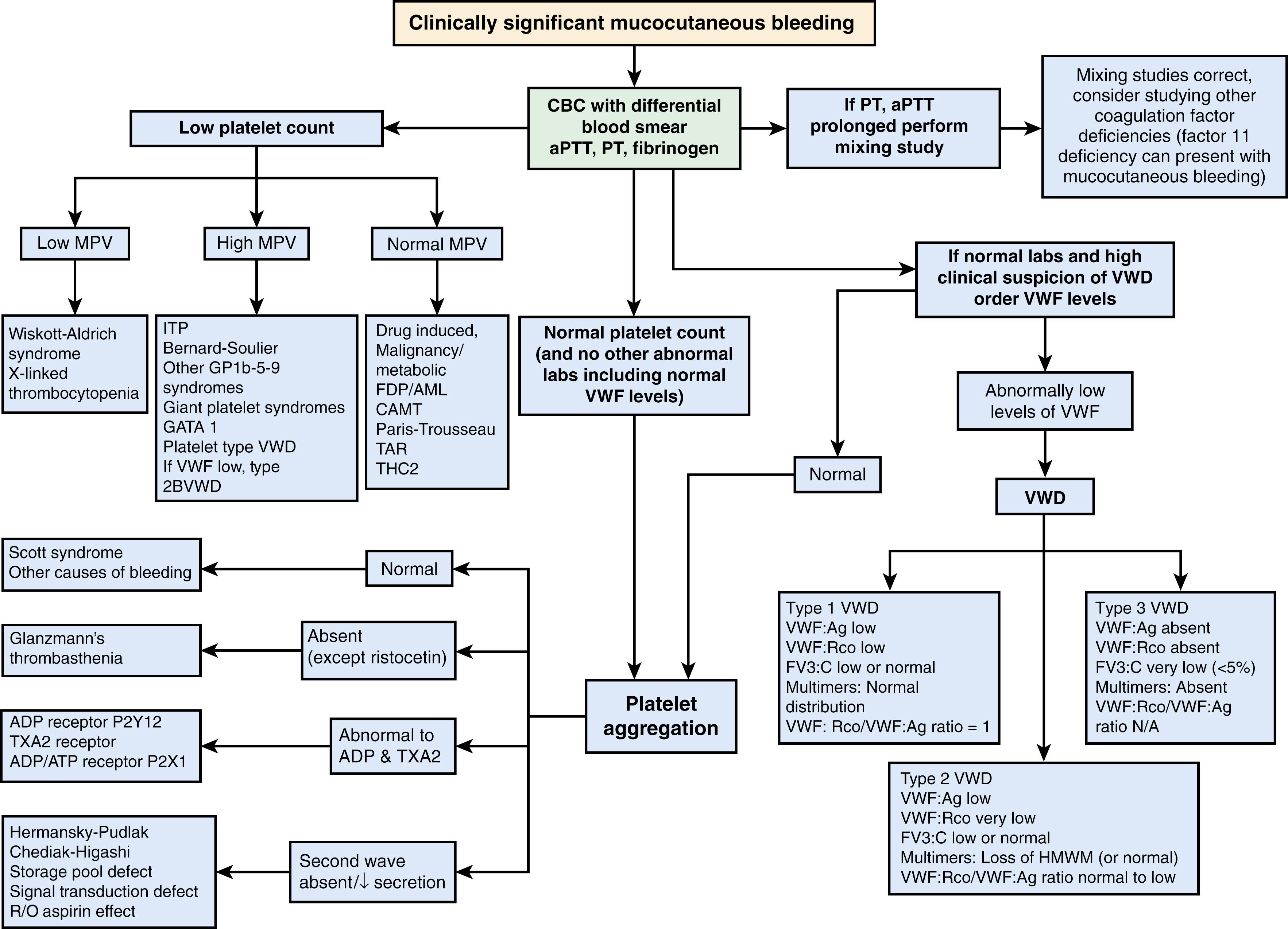
If there is high suspicion for an underlying bleeding disorder, specific screening for von Willebrand disease (VWD) and platelet function defects should be considered even if the PT and PTT are normal. There are no simple tests to screen for a thrombotic tendency.
The PT and PTT ( Fig. 51.6 ) are measures of all the coagulation factors except factor 13. Fibrinogen function should be measured as fibrinogen activity or TT. The PTT is the screening test that checks for deficiency of all clotting factors except factors 7 and 13. The PTT can be prolonged either by a deficiency of a clotting factor or by the presence of an agent in the plasma that delays the clotting time (an inhibitor). The PT is especially sensitive to deficiencies of factor 7.
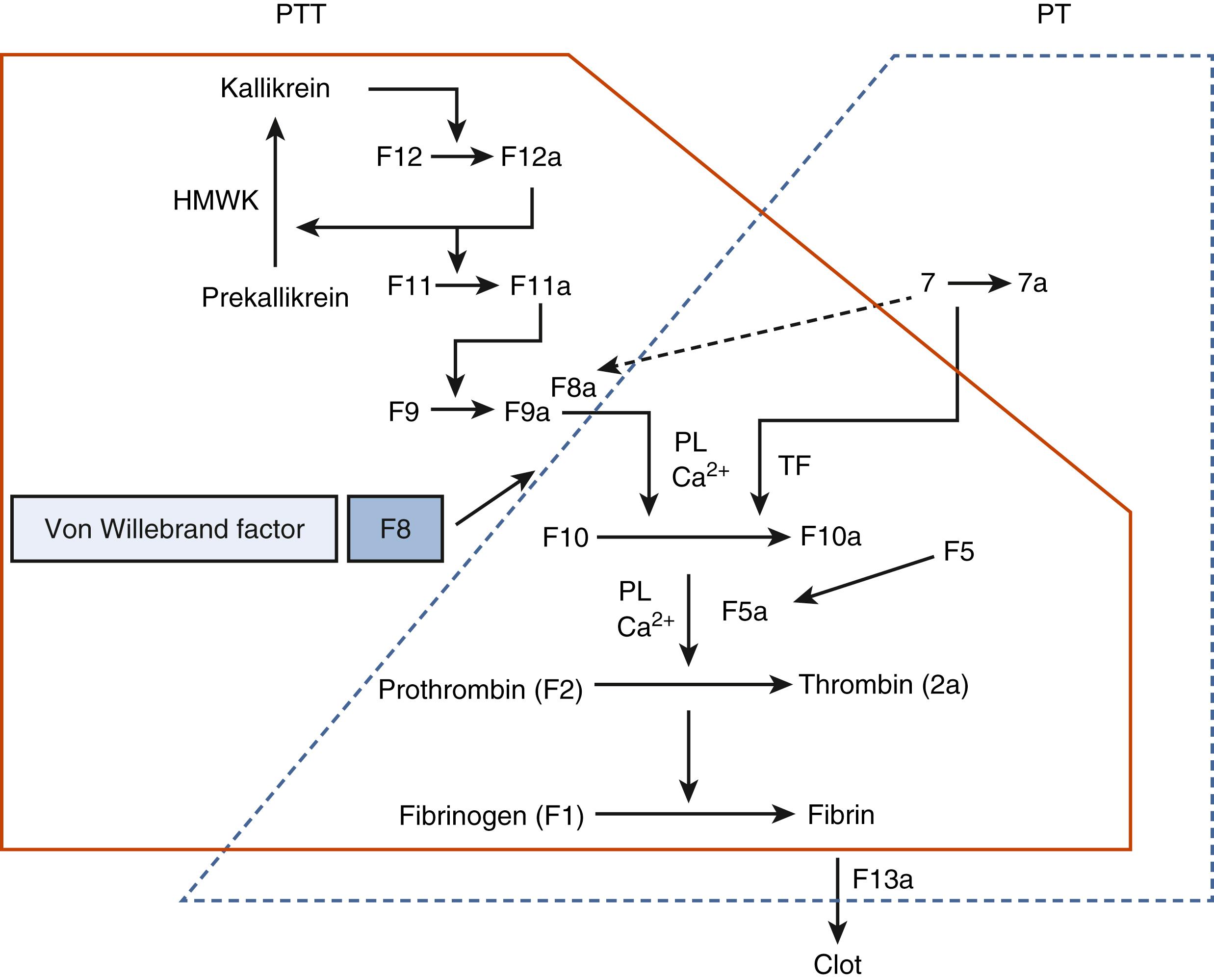
To test for an inhibitor, one part of the patient’s plasma is mixed with one part of pooled normal plasma obtained from 20–50 healthy adults. Pooled normal plasma provides a 100% level of each clotting factor. If mixed 1:1 with plasma that is deficient in one or several factors, the mixture should possess at least a 50% level of each factor and the PTT should correct to the normal range. If an inhibitor is present, the PTT usually does not correct to normal. The most common types of inhibitors include anticoagulants, such as heparin, and autoantibodies directed against either specific clotting factors (factor 8 inhibitors) or the phospholipid substances used in the PTT (lupus-type anticoagulants).
The PTT is especially sensitive to deficiencies of factors 8, 9, and 11 (hemophilia A, B, and C, respectively), as well as 12. A prolonged PTT in an asymptomatic child is most commonly caused by factor 12 deficiency or by a lupus-type anticoagulant, neither of which cause clinically significant coagulopathy. The PTT can also yield a false result if preanalytic variables are not adequately controlled:
When poor venipuncture technique, by adding TF to the blood, activates clotting and artifactually shortens the PTT
When insensitive laboratory reagents fail to detect clinically significant deficiencies (most common in mild factor 9 deficiency)
When the citrate concentration is not corrected for blood with a high hematocrit (in neonates and in patients with cyanotic congenital heart disease), leading to a prolonged PTT
The bleeding time is an indirect measure of platelet number and a more direct measure of platelet function, vascular integrity, and platelet interaction with the vascular subendothelium. As such, the bleeding time is usually abnormal in patients with thrombocytopenia, platelet function abnormalities, abnormal collagen (Ehlers-Danlos syndrome), and VWD. Unfortunately, because of its insensitivity and high level of variability, the bleeding time is a relatively poor tool for detecting the milder forms of these hemostatic disorders and cannot be used to rule out VWD and mild or moderate platelet function deficits. It is rarely used in the United States.
The sensitivity and specificity of platelet function analysis are insufficient for diagnosis, but it may have utility as a screen for severe platelet function defects in very small infants where rapid results are needed and size prohibits collection of large volumes of blood needed for platelet aggregation testing.
Figs. 51.7 and 51.8 provide an approach to evaluate the patient with an isolated prolongation of the PT or PTT.
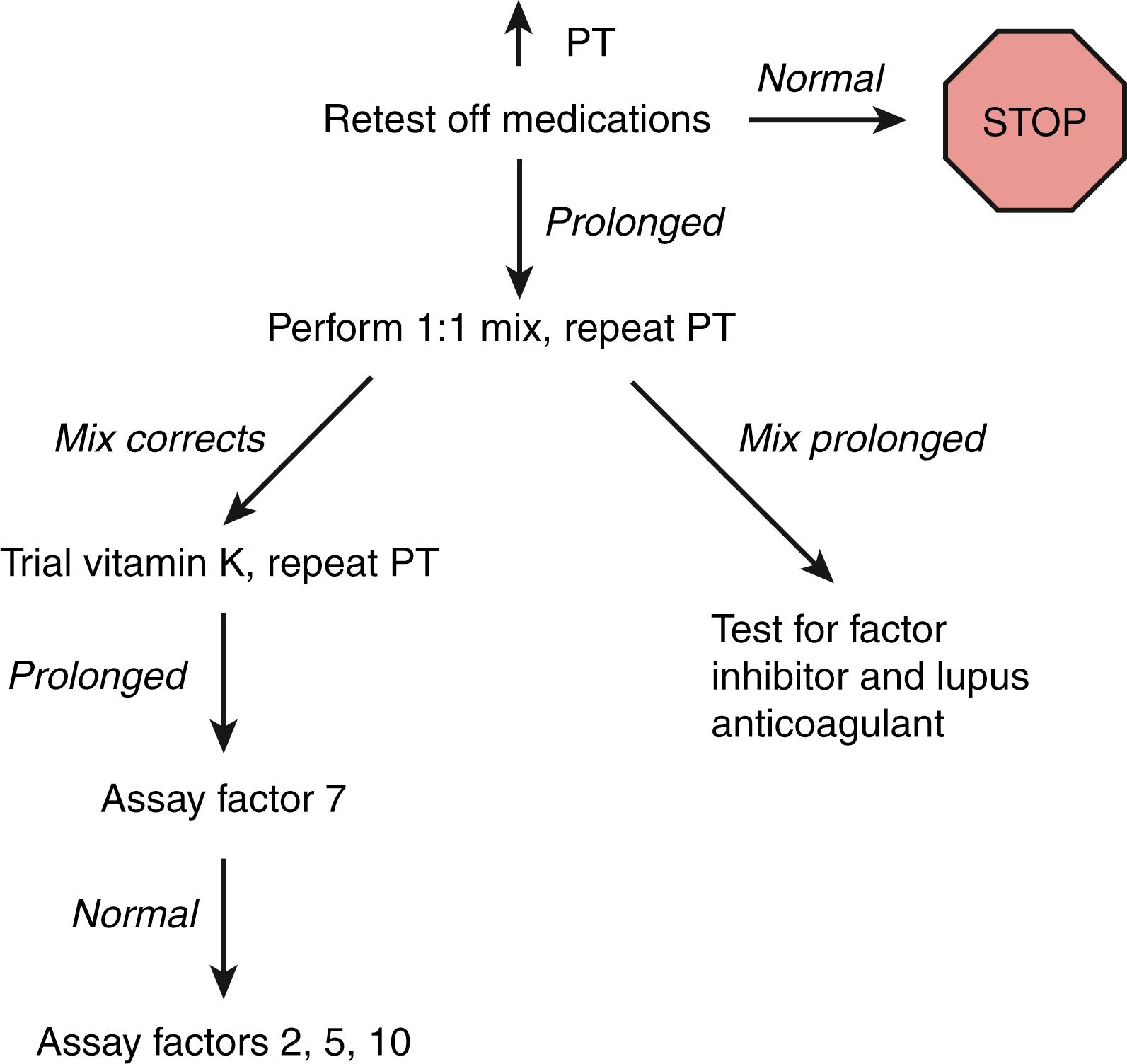
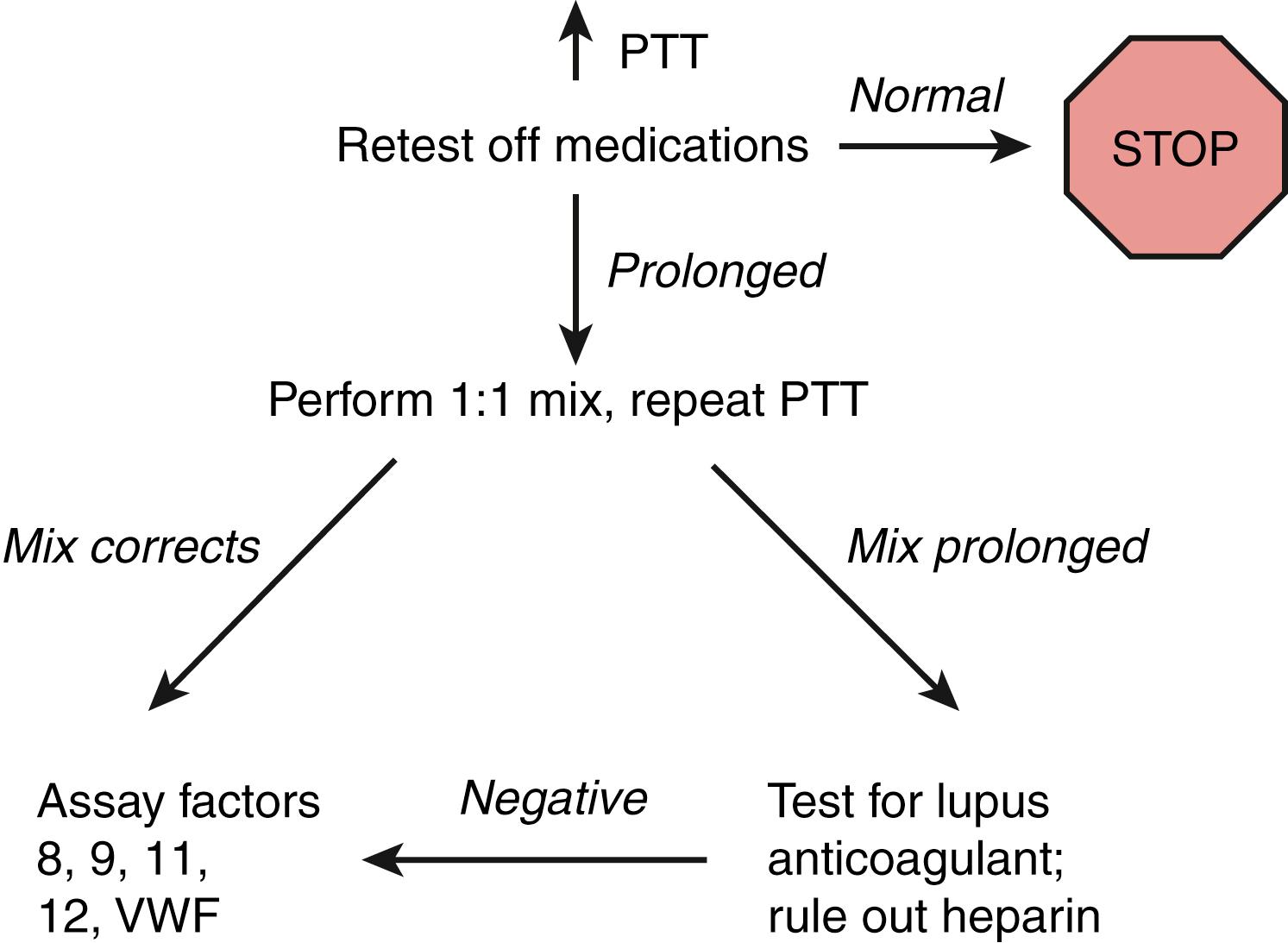
Become a Clinical Tree membership for Full access and enjoy Unlimited articles
If you are a member. Log in here